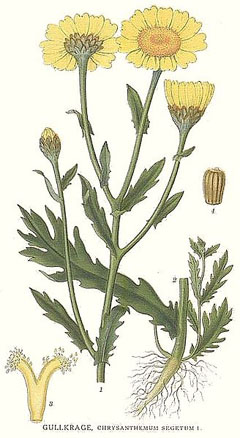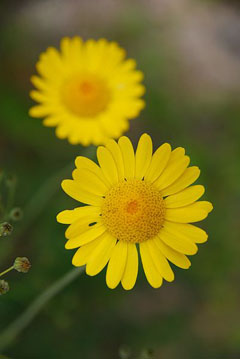 |
|
http://commons.wikimedia.org/wiki/File:11_Chrysanthemum_segetum.jpg |
 |
| http://commons.wikimedia.org/wiki/User:Lilly_M |
Translate this page:
Summary
Physical Characteristics

 chrysanthemum segetum is a ANNUAL growing to 0.5 m (1ft 8in). It is in flower from June to August, and the seeds ripen from July to September. The species is hermaphrodite (has both male and female organs) and is pollinated by Bees, flies, beetles, Lepidoptera (Moths & Butterflies). The plant is self-fertile.
chrysanthemum segetum is a ANNUAL growing to 0.5 m (1ft 8in). It is in flower from June to August, and the seeds ripen from July to September. The species is hermaphrodite (has both male and female organs) and is pollinated by Bees, flies, beetles, Lepidoptera (Moths & Butterflies). The plant is self-fertile.
Suitable for: light (sandy), medium (loamy) and heavy (clay) soils and prefers well-drained soil. Suitable pH: mildly acid and neutral soils. It can grow in semi-shade (light woodland) or no shade. It prefers moist soil.
UK Hardiness Map
US Hardiness Map
Synonyms
Plant Habitats
Cultivated Beds;
Edible Uses
Edible Parts: Leaves Shoots
Edible Uses:
Young shoots - cooked[2, 61, 105, 177, 183]. Strongly aromatic, they contain coumarin[179]. Caution is advised, see the notes above on toxicity.
References More on Edible Uses
Medicinal Uses
Plants For A Future can not take any responsibility for any adverse effects from the use of plants. Always seek advice from a professional before using a plant medicinally.
None known
References More on Medicinal Uses
The Bookshop: Edible Plant Books
Our Latest books on Perennial Plants For Food Forests and Permaculture Gardens in paperback or digital formats.

Edible Tropical Plants
Food Forest Plants for Hotter Conditions: 250+ Plants For Tropical Food Forests & Permaculture Gardens.
More

Edible Temperate Plants
Plants for Your Food Forest: 500 Plants for Temperate Food Forests & Permaculture Gardens.
More

More Books
PFAF have eight books available in paperback and digital formats. Browse the shop for more information.
Shop Now
Other Uses
Dye
None known
Special Uses
References More on Other Uses
Cultivation details
Succeeds in ordinary garden soil[1], though it prefers a well-drained fertile soil in full sun[200]. Grows well in sandy soils[188]. Dislikes lime[17]. Cultivated as a vegetable in China and Japan[61, 266]. There are several named varieties selected for their ornamental value[[200].
References Carbon Farming Information and Carbon Sequestration Information
Temperature Converter
Type a value in the Celsius field to convert the value to Fahrenheit:
Fahrenheit:
The PFAF Bookshop
Plants For A Future have a number of books available in paperback and digital form. Book titles include Edible Plants, Edible Perennials, Edible Trees,Edible Shrubs, Woodland Gardening, and Temperate Food Forest Plants. Our new book is Food Forest Plants For Hotter Conditions (Tropical and Sub-Tropical).
Shop Now
Plant Propagation
Seed - sow spring in situ. The seed usually germinates within 10 - 18 days at 15°c. Autumn sowings succeed in mild areas[200].
Other Names
If available other names are mentioned here
Native Range
TEMPERATE ASIA: Cyprus, Israel, Jordan, Lebanon, Syria, Turkey (southwest) EUROPE: Albania, Bosnia and Herzegovina, Greece (incl. Crete), Italy (incl. Sardinia, Sicily), Spain (incl. Baleares), France (incl. Corsica) AFRICA: Algeria (north), Libya (north), Morocco, Tunisia
Weed Potential
Right plant wrong place. We are currently updating this section.
Please note that a plant may be invasive in one area but may not in your area so it's worth checking.
Conservation Status
IUCN Red List of Threatened Plants Status :

| Related Plants
|
| Latin Name | Common Name | Habit | Height | Hardiness | Growth | Soil | Shade | Moisture | Edible | Medicinal | Other |
| Artemisia vulgaris | Mugwort, Common wormwood, Felon Herb, Chrysanthemum Weed, Wild Wormwood | Perennial | 1.2 |
3-9
| F | LMH | SN | DM | 2 | 3 | 3 |
| Chrysanthemum carinatum | Tricolor Chrysanthemum, Painted Daisy, Summer Chrysanthemum | Annual | 0.6 |
0-0
| F | LMH | SN | M | 2 | 0 | |
| Chrysanthemum coronarium | Chop-Suey Greens | Annual | 1.2 |
0-0
| | LMH | SN | M | 3 | 2 | 2 |
| Chrysanthemum coronarium spatiosum | Chop-Suey Greens | Annual | 1.2 |
0-0
| | LMH | SN | M | 3 | 2 | 2 |
| Chrysanthemum marshallii | | Perennial | 0.0 |
-
| | LMH | SN | M | 0 | 0 | 3 |
| Chrysanthemum segetum | Corn Marigold | Annual | 0.5 |
-
| | LMH | SN | M | 1 | 0 | |
| Dendranthema indicum | Chrysanthemum | Perennial | 0.6 |
5-9
| | LMH | N | M | 2 | 3 | 1 |
| Dendranthema x grandiflorum | Chrysanthemum, Cut Mum, Garden Mum, Pot Mum, Florist's Chrysanthemum | Perennial | 1.5 |
5-10
| M | LMH | N | M | 2 | 3 | 2 |
| Leucanthemum maximum | Shasta Daisy, Max chrysanthemum | Perennial | 0.8 |
5-9
| | LMH | N | M | 0 | 0 | |
|
Growth: S = slow M = medium F = fast. Soil: L = light (sandy) M = medium H = heavy (clay). pH: A = acid N = neutral B = basic (alkaline). Shade: F = full shade S = semi-shade N = no shade. Moisture: D = dry M = Moist We = wet Wa = water.
Now available:
Food Forest Plants for Mediterranean Conditions
350+ Perennial Plants For Mediterranean and Drier Food Forests and Permaculture Gardens.
[Paperback and eBook]
This is the third in Plants For A Future's series of plant guides for food forests tailored to
specific climate zones. Following volumes on temperate and tropical ecosystems, this book focuses
on species suited to Mediterranean conditions—regions with hot, dry summers and cool, wet winters,
often facing the added challenge of climate change.
Read More
Expert comment
Author
L.
Botanical References
17200
Links / References
For a list of references used on this page please go here
Readers comment
| Add a comment |
|
If you have important information about this plant that may help other users please add a comment or link below. Only comments or links that are felt to be directly relevant to a plant will be included. If you think a comment/link or information contained on this page is inaccurate or misleading we would welcome your feedback at [email protected]. If you have questions about a plant please use the Forum on this website as we do not have the resources to answer questions ourselves.
* Please note: the comments by website users are not necessarily those held by PFAF and may give misleading or inaccurate information.
To leave a comment please Register or login here All comments need to be approved so will not appear immediately.
|
Subject : chrysanthemum segetum
|
|
|
|